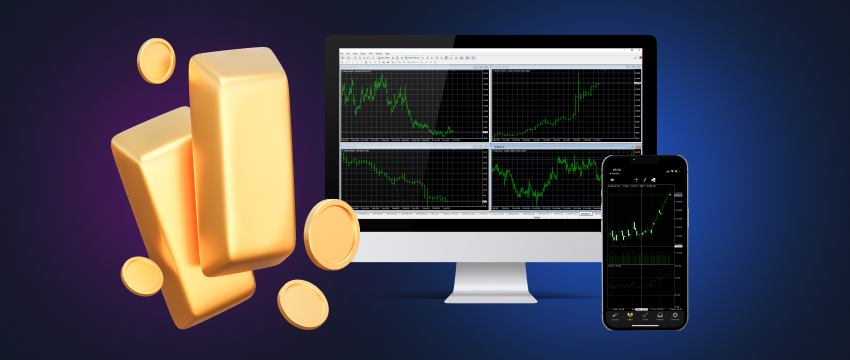Gold prices have increased significantly this year, rising as much as 30% year-to-date when they hit a peak of $3,500/oz in April – well above J.P. Morgan Research’s earlier forecasts.
With markets facing policy and geopolitical risks, what’s next for gold in 2025?
J.P. Morgan Research now expects prices to average $3,675/oz by the last quarter of 2025, rising toward $4,000/oz by the second quarter of 2026.
Why gold is soaring
The precious metal hit multiple record highs in 2024 and crossed the $2,900/oz barrier for the first time in February this year, as investors navigated market volatility after U.S. tariffs and increased geopolitical risks. Prices then peaked at $3,500/oz in April amid unpredictable U.S. trade policy.
Traditionally, a weaker U.S. dollar and lower interest rates make non-yielding bullion more attractive. Economic and geopolitical uncertainty also tend to boost gold, due to its safe-haven status and reliability as a store of value. With low correlation to other asset classes, gold can act as a form of insurance during falling markets and periods of geopolitical stress.
Given gold’s diverse and fluid drivers of demand at the moment, the metal has recently acted as both a hedge against currency devaluation and inflation, while also serving its more traditional role as a non-yielding competitor to U.S. Treasuries and money market funds.
Gregory Shearer, head of Base and Precious Metals Strategy at J.P. Morgan said “We still think risks are skewed toward an earlier overshoot of our forecasts if demand continues to surprise our expectations. For investors, we think gold remains one of the most optimal hedges for the unique combination of stagflation, recession, debasement and U.S. policy risks facing markets in 2025 and 2026.”
Who is buying gold in 2025?
After gold’s impressive 30% rally, some investors are asking who the major buyers of gold will be in 2025, at current prices levels.
J.P. Morgan Research anticipates that strong demand from both investors and central banks will continue, which is projected to average around 710 tonnes per quarter on net this year.
Central banks
Central banks are expected to maintain high levels of gold purchases, with around 900 tonnes forecasted for 2025, driven by the current macro environment and continued growth in investor holdings, particularly from exchange-traded funds (ETFs) and China.
Even after three consecutive years of over 1,000 tonnes of gold purchases, the structural trend of rising central bank buying is expected to continue through 2025 and 2026, according to J.P. Morgan Research.
Diversification away from U.S. dollar reserve holdings, while still moderate, has accelerated in recent years, according to the latest Currency Composition of Official Foreign Exchange Reserves (COFER) data from the International Monetary Foundation (IMF). Although USD share increased slightly in Q4 2024, it ended the year at about 57.8%, a decline of 0.62 percentage points.
Globally, central bank gold holdings now total nearly 36,200 tonnes, representing almost 20% of official reserves, up from around 15% at the end of 2023.
The U.S., Germany, France and Italy hold about 16,400 tonnes of gold, nearly half of global official gold reserves, with the U.S. holding almost a quarter. Each of these four countries keeps over 70% of its total reserves in gold. Taking out these four major holders, gold’s share in official reserves drops to just above 11%.
Markets hold their breath ahead of
Powell Jackson’s speech
Stocks may remain under pressure until Jay Powell speaks at the Jackson Hole podium on Friday 22 August. Gold traders are also tuning in for any hints of rate-cuts from the Fed chief.
Lower interest rates or increasing sentiment for that have historically supported gold, as they lower the opportunity cost of holding the asset. When rates fall, returns on interest-bearing investments like bonds and savings accounts decline, making gold more attractive.
Recent data showing weak jobs numbers and less worrying inflation have driven hopes for a September rate cut, though some analysts warn that Powell may take a more cautious approach this week.
UBS Global Wealth Management strategists are increasing their bullish stance on gold, raising price targets for the asset. Gold has gained 28% this year, outperforming all major stock and bond indexes, G-10 currencies and even bitcoin.
Led by Wayne Gordon, the team now expects gold prices, trading at $3,388 on Tuesday, to reach $3,600 per ounce by end March 2026 and $3,700 by end June 2026, both up from previous targets of $3,500 per ounce. They also introduced an end-September 2026 target of $3,700 an ounce.
The strategists still continue to target $3,500 for the end of this year.
“Despite the dialling back of some trade frictions, we see U.S. macro-related risks, questions over Fed independence, worries about fiscal sustainability, and geopolitics underpinning de-dollarization trends and more central bank buying. In our view, these factors will drive gold prices even higher,” said Gordon and his team.
They say that persistent U.S. inflation, with effects from tariffs and immigration crackdowns, combined with below-trend growth, is likely to push real U.S. yields lower, lowering the opportunity cost of holding gold.
Gold demand set to remain strong in 2026
Looking ahead to 2026, investment demand for gold is expected to stay strong, supported by de-dollarisation trends, questions over Fed independence, and concerns about the U.S. fiscal outlook, especially with midterm elections approaching after September, according to the UBS team.
Central bank buying is expected to stay strong as well, slightly below last year’s near-record levels.
Global gold demand is forecast to rise 3% in 2025 to 4,760 metric tons, the highest level since 2011. The main risk for gold is if the Fed is forced to hike rates.
Gold prices slowed over the summer after a strong start to the year, but they still managed to reach a new high of $3,439.20 high on July 22. The metal’s popularity continues to grow – DoubleLine’s Jeffrey Gundlach earlier this summer called gold a real asset class, saying it was “no longer for lunatic survivalists and wild speculators.
Tempering some of the gold enthusiasm, Callum Thomas, head of research and founder of Topdown Charts, shared his perspective on the commodity in a post on Monday 18 August. He sees a shift in focus from gold to other commodities, with industrial metals likely to catch up to gold’s strong performance.
Disclaimer: This material is for general informational and educational purposes only and should not be considered investment advice or an investment recommendation. T4Trade is not responsible for any data provided by third parties referenced or hyperlinked in this communication.



